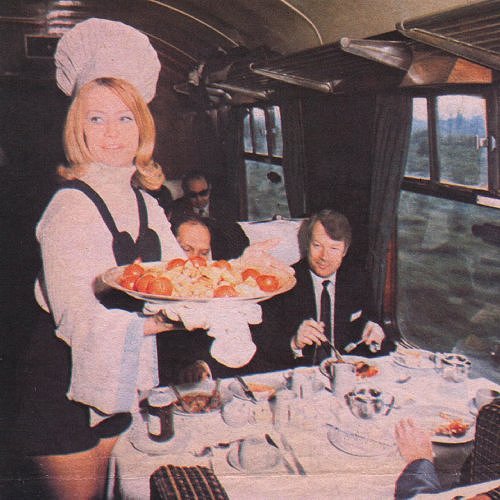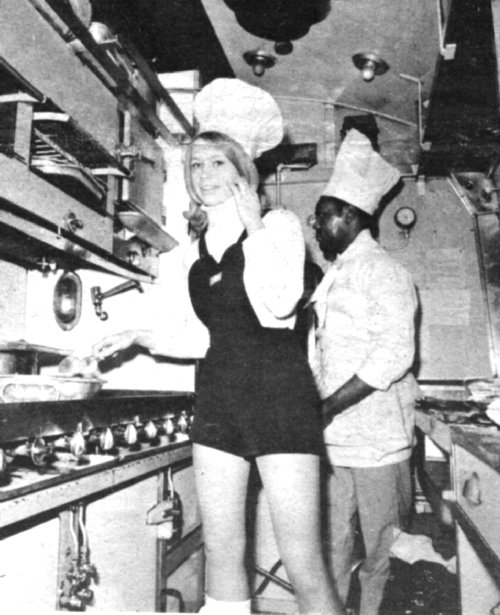
Our thanks for assistance in the production of this article go to : Mr I.Fyvie, Mr. S. Smalley, Mr. A. Wood (Watercress Line), and our sponsors, Mr C.G. Stirling and Mr. R. Black (Strathspey Rly), and Mr. B. Denton (North Norfolk Rly.) for inclusions to our articles.
Since the arrival of public services to railway timetables, the requirement for refreshments has been expected by the customer. In it's infancy, provision was made at stations only, utilising the changing of trains and waiting arrivals. This took the form of a cold collation originally, and upon being found to be profitable, extended to hot snacks. Dispensing machines added to the offerings, but the public wanted more.
The fast express services now appearing required a form of catering for the long distance traveller, and in the case of certain services on the L.N.E.R, the train crew also. Specifically designed coaching stock provided a means of moving about the length of the train, and this gave rise to the buffet car being designed. Not content with this alone, a dining set was also called for, to be included in prestigious "named" expresses. Each region vied with each other in the opulence of their dining services, as fitting the nature of competition between them, with the more notable services acquiring new names, i.e. "Master Cutler" etc.
To the extent of prospective further business, Railway Hotels started to appear for the weary traveller. These were magnificent structures suitable for a five star rating, and came in a wide range of architectural styles. Regretfully, a lot of these have now been turned to other uses or re-developed. The railways had also expanded to the seas with their own fleets of steam ships, making for a total package in transportation. As the railways grew, there came a need for overnight travel; this brought about sleeping car facilities on long distance hauls.
This was an exciting time for both railwayman and the general public; style, panache, comfort and speed were the subjects of the day, and train-spotters abounded in proliferation wherever and whenever they could.
The variety of locomotive stock was colossal, and through workings meant that generally there was always something of interest to the observer. Brightly coloured locos mixing with black ones gave an interest which the modern railway had all but totally lost until recent years, but the interest for the "spotter" has faded significantly, perhaps permanently.
The first rate dining services have gone from main line workings, but have been a saviour for preservation societies, eager to maintain a way of life that has passed into history, along with so many aspects of Britain's railway system.
Pictures - Cat.1-3. Though the uniforms aren't correct, the food is most agreeable, and the rolling stock more or less unchanged !


I am now proud to bring you an amusing story or two, passed to me by a friend of ours, who recounts a trip taken circa the mid-forties :
Aunt Florrie took me to Guide Bridge Station as I was going to visit my Dad. He was repairing telephone lines in London during the Blitz. On arriving at London Road Station, Manchester, I went to what engines were on the platforms, as only the carriages were at my departure platform, when, to my amazement, Sir Nigel Gresley pushing a corridor coach backed on to my train.
You didn't see many corridor coaches at that time. "Have a good run", I called to the driver and fireman. One replied "We have a ten minute stop at Crewe", so on I jumped and got a corner seat at the window and we were off. At that moment, a young lady appeared and opened the carriage sliding door, and I saw she had a small Yorkie Terrier in her arms, but she had no luggage. I offered to hold her dog while she took off her coat and got settled, then we talked about this and that for a few minutes. She said her dog was thirsty, and she took it to the toilet to get it a drink from the tap, but back she came straight away and asked if I would help her.
"Tap were too hard to turn"so off I went to help. Well we had no sooner got into the toilet, when she shut the door, saying, "Seven and sixpence Dearie". I told her she didn't have to give me anything for helping her. "NO! NO!" she exclaimed, "7/6d and I will show you a good time !". "NAY! NAY! lady" I said, "We'll be at Crewe in a few minutes and I'll have a good time walking about the platforms to see what trains there are!"
"Well what could be a better good time than that!" So, I like I said in the subject matter, AH WERE AS THICK AS A PLANK!!!!!
There have been all manner of practices brought about in the past enabling efficient running of the railways. Some of these have been somewhat questionable, and some have caused panic to bystanders. A classic example of this would be the "slip coach"; namely a coach or two fitted with a device to disconnect it from the main train at speed, allowing it to coast freely onto a branch line. The secondary guard would control the detachment of the vehicle, and bring the coach(es) to a halt using the brake fitted. Though this type of service wasn't uncommon to railwaymen, frequent panic reports of "break-aways" made them less than popular with station masters, courtesy of the general public. This practice has now ceased, due to few branch lines being left, and also being frowned upon by the safety inspectorate.
Goods were no exception to Murphy's Law, either. The conveyance of livestock produced problems of it's own, featuring spirited race horses trying to beat the train they were to be transported by, furious bulls disassembling cattle trucks to the alarm of all, and crates of chicks finding a new freedom within the parcels offices. In fact, goods came in all shapes and sizes, and fees charged for transportation provided clerks with frequent head-aches, never mind the previous mentioned problems ! Of course, these antics were usually far from the eyes of the general public, but amusing, never the less.
Most of these incidents stemmed from branch lines and country halts, which no doubt had more than their fair share of anecdotes. One example was of a station awaiting a V.I.P. inspection, with a goods train to clear the station before the arrival of the V.I.P.'s train. At the time, the fashion was that milk was conveyed in churns on the platform of the guards' van for ease of handling, and such was the case this day.
Staff had spent hours painting, polishing, cleaning etc. and the station was immaculate, with staff in their best uniforms and flower-beds weeded. The crew of the passing freight were behind schedule, and determined to make up the lost time as they got a right-away. The exhaust bellowed, the couplings snatched, and the milk churn emptied it's contents along the entire length of the platform as the freight cleared the station in haste, leaving staff dripping milk. All in a day's work, so they say!
Not quite what you'd think to be a source of amusement, but even goods yards had their moments - the "Hump Shunting Yards" were so arranged that wagons were driven up the hump, uncoupled, and left to roll under their own inertia into the road (siding) allocated to that vehicle. In their infancy, the shunter applied the brake manually, usually with the uncoupling hook known as a shunter's pole.
This was a less than shunter-friendly method, which resulted in the hook ensnaring itself in the brake mechanism of an occasion, leading to an unscheduled ride for the unfortunate shunter. No brake, sixteen tons at average finding it's own speed, and a very noisy shunter trying to release both himself and his hook, before the inevitable rapid halt against other wagons.
A most evidently welcome improvement was the development of the rail-brake, where a secondary rail on pivots and hydraulically driven acted against the inside of the wheels as a form of disc-brake. These devices were operated from the yard office, leaving the shunter free to simply uncouple wagons in relative safety. This new device had an unexpected benefit for the yards they were fitted in, it enabled a faster sorting of wagons, which was no bad thing, with Toton Yard (Nottingham) handling massive amounts of goods per hour.
For the residents near Toton, the eventual demise of steam and goods could not be missed on New Year's Day, as the tradition of the yard was to "Pipe In The New Year". This was accomplished by possibly as many as 200 locos sounding their whistles in uniformity. The yard now stands empty and overgrown, the herald of the coming year sounds no more.
Dirty and inefficient though the steam locomotive was, there's no doubt that with it's demise, a certain quality of life also disappeared. The olfactory effects of these machines and their work have left an indelible mark on people who otherwise had very little to do with the railways, indeed a way of life for some without them ever realizing it.
Well, that's all for now. I hope that Steam Corner is informative and amusing for you all - and if any of you have never seen a steam train, do so.
Baz.
